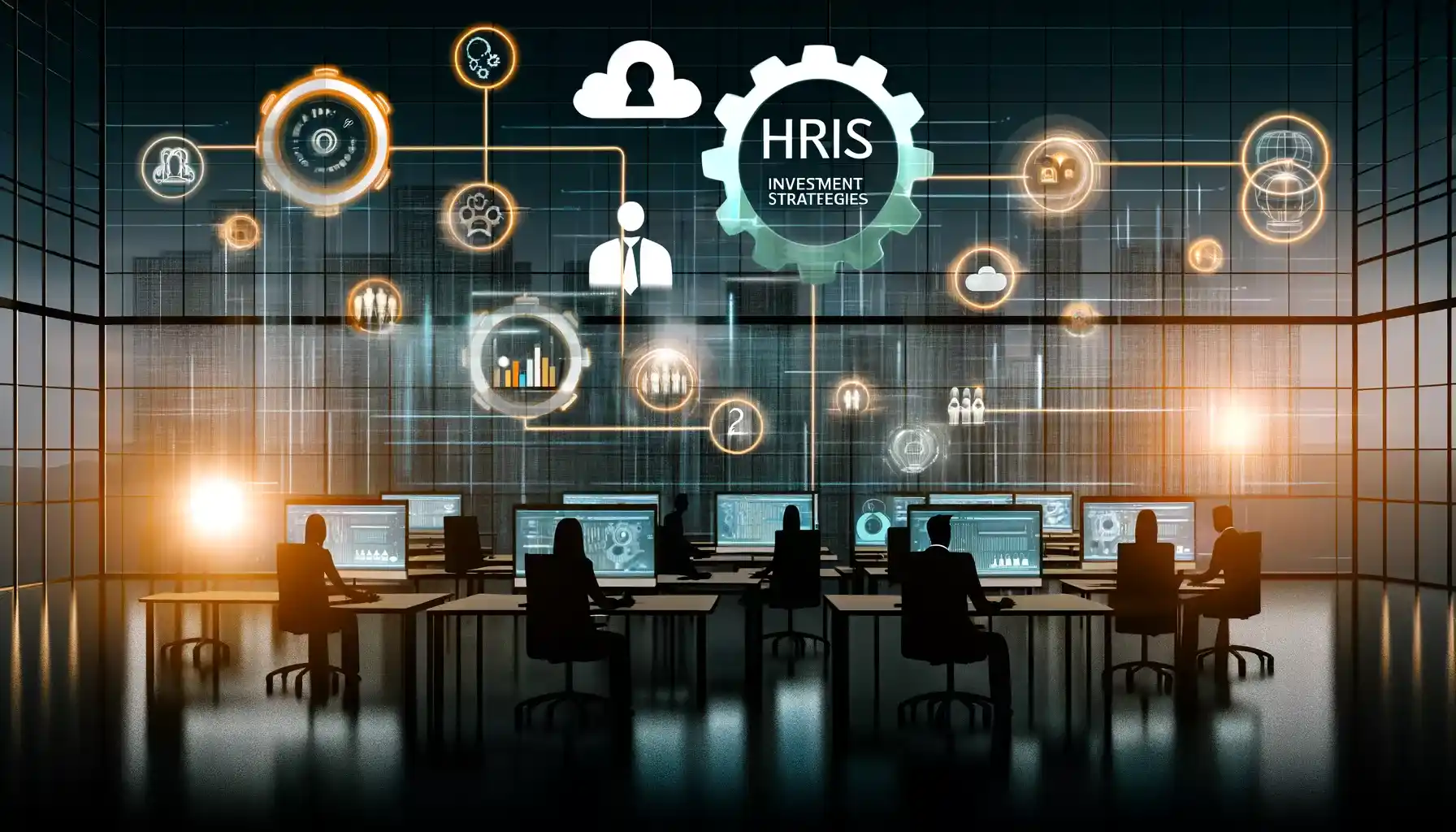Table of Contents
In today’s competitive business landscape, organizations recognize the pivotal role of Human Resource Information Systems (HRIS) in streamlining HR processes, enhancing employee experiences, and driving overall efficiency. However, the journey to harness the full potential of HRIS begins with strategic investments and prudent decision-making. By adopting smart HRIS investment practices, companies can unlock significant value and gain a competitive edge in talent management and operational excellence.
Understanding HRIS Investment
HRIS Investment involves procuring and integrating software solutions designed to streamline various HR functions. These systems offer a broad array of features such as payroll management, employee data tracking, recruitment tools, performance assessment modules, and talent management capabilities. The core objective of HRIS Investment is to boost operational efficiency, facilitate informed decision-making, and optimize the management of personnel-related processes.

Here are a few illustrations of HRIS solutions:
- SAP SuccessFactors: HRIS Investment is an integrated cloud-based HRIS platform that offers modules for core HR functions, performance management, learning and development, and workforce analytics.
- Workday: HRIS Investment is a comprehensive solution encompassing modules for human capital management, payroll, talent acquisition, and workforce planning. It provides real-time data analytics and insights, facilitating strategic decision-making.
- Oracle HCM Cloud: A suite of HRIS applications covering core HR, talent management, payroll, and workforce analytics. It enables organizations to manage their entire workforce lifecycle efficiently.
- BambooHR: A user-friendly HRIS platform for small to medium-sized businesses, offering features like applicant tracking, employee onboarding, performance management, and reporting tools.
- ADP Workforce Now: An all-in-one HRIS solution catering to payroll processing, benefits administration, time and attendance tracking, talent management, and compliance management.
Strategies for Justifying HRIS Investments
When justifying HRIS investments, strategies typically fall into two categories:
- Cost Reduction: HRIS solutions, such as automated payroll systems or self-service portals, streamline administrative tasks, reducing the need for manual intervention. For illustration, implementing a time-tracking module within an HRIS can automate timekeeping processes, eliminating the need for manual timesheets and reducing errors. This automation saves time and labor costs associated with manual data entry. Additionally, HRIS solutions can centralize data storage and management, reducing the need for paper-based records and physical storage space. This cuts down on administrative overhead and improves data accuracy and accessibility. For instance, a company adopting an HRIS with cloud-based storage can eliminate the costs of maintaining physical file cabinets and reduce the risk of document loss or damage.
- Value Creation: Smart organizations leverage HRIS investments to empower employees and drive strategic initiatives. For illustration, implementing a learning management system (LMS) within an HRIS enables employees to easily access training materials and courses, fostering continuous learning and skill development. This empowers employees to grow professionally, enhancing their contributions to the organization and driving innovation. Moreover, HRIS solutions can support strategic workforce planning by providing insights into workforce demographics, skills gaps, and performance metrics. For instance, analytics tools integrated into an HRIS can help identify trends in employee turnover or performance, enabling HR teams to make data-driven decisions to optimize staffing levels and talent retention strategies. This alignment with organizational goals enhances productivity and supports long-term business objectives.
The HRIS Strategy

An HRIS (Human Resource Information System) strategy is a roadmap that guides how a company intends to utilize HRIS solutions to meet its HR and overall business goals. It involves several key components:
- Identifying Requirements: This entails understanding the specific needs of the organization, such as streamlining HR processes, enhancing employee engagement, or improving data analytics capabilities.
- Selecting Vendors: Choosing the right HRIS vendors involves evaluating various options based on factors like functionality, cost, scalability, and compatibility with existing systems.
- Defining Implementation Timelines: Establishing clear timelines ensures the implementation process stays on track and aligns with organizational priorities and deadlines.
- Establishing Metrics: Metrics are essential for measuring the success of the HRIS strategy. These could include key performance indicators (KPIs) for efficiency improvements, cost savings, employee satisfaction, or talent retention rates.
Why do Companies Invest in HRIS?
Companies invest in HRIS for various reasons:
- Efficiency and Productivity: HRIS solutions streamline HR processes by automating tasks like payroll, time tracking, and benefits administration. For instance, systems like Workday or BambooHR offer features such as automated workflows for approvals and notifications, reducing the time spent on manual paperwork. This allows HR teams to focus on strategic initiatives like talent management and employee development.
- Data-driven decision-making: HRIS provides real-time data and analytics on various HR metrics such as employee turnover, performance ratings, and diversity statistics. For instance, platforms like ADP or Oracle HCM Cloud offer customizable dashboards and reporting tools, enabling organizations to identify trends and patterns within their workforce. This data-driven approach helps in making informed decisions related to recruitment strategies, training programs, and resource allocation.
- Compliance and Risk Management: HRIS systems help organizations stay compliant with regulations such as GDPR, FMLA, and EEOC by maintaining accurate employee records and automating compliance reporting. For instance, software like SAP SuccessFactors or Kronos Workforce Ready offers features like document management and audit trails to ensure data integrity and regulatory adherence. Additionally, these systems can track certifications and licenses, ensuring that employees meet job requirements and reducing non-compliance risk.
- Employee Experience: HRIS solutions improve the employee experience by offering self-service portals, personalized communication, and seamless onboarding experiences. For instance, platforms like Zenefits or Namely allow employees to update their personal information, enroll in benefits, and access HR policies online, reducing dependency on HR staff for routine inquiries. Moreover, features like automated welcome emails and interactive training modules enhance the onboarding process, making new hires feel valued and engaged from day one.
Types of HRIS
- Core HRIS: These systems focus on fundamental HR functions like managing employee data, processing payroll, administering benefits, and tracking attendance. Illustrations include:
- ADP Workforce Now
- BambooHR
- Paycom
- Strategic HRIS: Strategic HRIS solutions extend beyond core functionalities to support strategic HR initiatives such as workforce planning, talent management, succession planning, and performance management. Illustrations include:
- Workday
- Oracle HCM Cloud
- SAP SuccessFactors
- Integrated HRIS: Integrated HRIS platforms seamlessly connect with other business systems like ERP (Enterprise Resource Planning), CRM (Customer Relationship Management), and accounting software. This integration ensures data consistency, streamlines processes, and facilitates cross-functional collaboration. Illustrations include:
- UltiPro
- Kronos Workforce Ready
- Ceridian Dayforce
- Cloud-based HRIS: These solutions, also known as Software-as-a-Service (SaaS) HRIS, are hosted on remote servers and accessed via the Internet. They offer scalability, flexibility, and cost-effectiveness, making them suitable for small and medium-sized businesses. Illustrations include:
- Namely
- Zenefits
- Gusto

Maximizing Value through Strategic HRIS Investment
Organizations recognize the pivotal role of Human Resource Information Systems (HRIS) in optimizing HR processes and driving operational efficiency. Strategic HRIS investment involves procuring and integrating software solutions to streamline various HR functions, enhance employee experiences, and facilitate informed decision-making. By adopting smart HRIS investment practices, companies can unlock significant value, gain a competitive edge in talent management, and propel overall business success.
From cost reduction strategies to value creation initiatives, HRIS investments offer diverse benefits, ranging from improved efficiency and productivity to data-driven decision-making and enhanced employee experiences. Through adopting core HRIS, strategic HRIS, integrated HRIS, and cloud-based HRIS solutions, organizations can tailor their approach to meet specific needs and achieve their HR and business objectives effectively. By strategically leveraging HRIS investments, companies can navigate evolving workforce challenges and position themselves for sustained growth and success in the digital era.